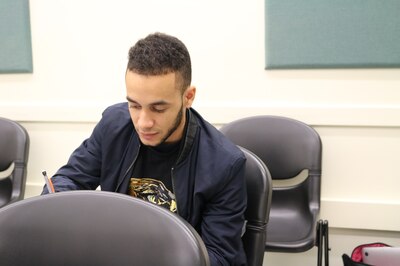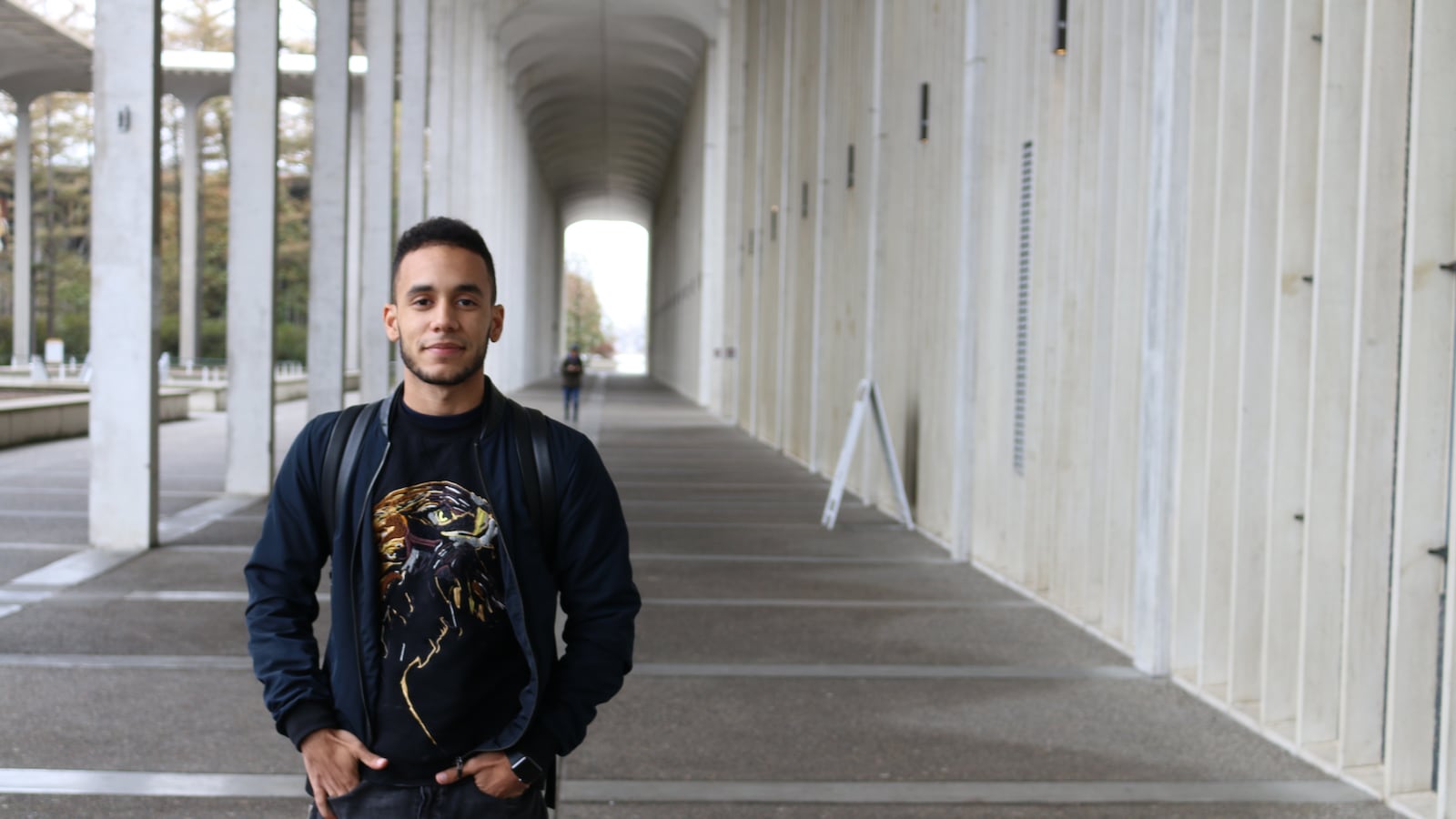Daviary Rodriguez, who goes by Davi, sat in the back of his calculus class at the University at Albany on a recent afternoon, taking notes as his professor sprawled math equations across the board.
When she told the class to work on problems, Davi, 18, grinned — he had already finished a couple questions while she was talking.
“I think it’s pretty easy,” he said, smiling.
As a freshman at the university, which is part of the State University of New York system, Davi is confident, excited about his newfound independence, and enjoying his classes. Still, as a first-generation college student from a working-class family in the Inwood neighborhood in New York City, Davi will have defied the odds if he makes it to graduation.
In New York City, officials have pushed to get more students like Davi to enroll in college — and it seems to be working. But a major hurdle remains: helping students persist once they get there. Less than 30 percent of students from average-income neighborhoods in the city graduate college in six years, and that number drops to 16 percent for those from the poorest neighborhoods, according to a recent NYU study.
With that grim statistic in mind, nonprofits, colleges, and even high schools are working to help students get to and through college. Davi is relying on several such programs to help push him across the graduation finish line.
With Thanksgiving days away and finals around the corner, we spoke with Davi recently about the highs and lows of his first semester in college.

A summer of strict rules and study hours
Davi got an early start on college — five weeks early, to be exact.
This summer, he took part in an intensive college-prep course through the Educational Opportunity Program (EOP), a 50-year-old program that provides academic and financial support to students from low-income families at public colleges across New York.
While his middle-class peers spent the waning days of summer bidding farewell to old friends, Davi was sitting through hours-long orientation lectures and silent study hours each night. In fact, the popular program — which enrolls motivated students who don’t meet SUNY’s typical admissions requirements — enforces a dress code during the summer orientation, bans cell phones outside of residence halls, and forbids participants from interacting with students who aren’t in the program, according to program rules obtained by the campus newspaper.
Maritza Martinez, the university’s Educational Opportunity Program director, said the strict rules are necessary to cram the basics of college life and academics into a brief summer course.
“We don’t have the luxury of not having a structured program,” she said. While low-income students typically are less likely to graduate than their peers, Martinez noted that the graduation rate among EOP participants is actually higher than the university’s overall rate.
During the summer crash course and throughout the school year, the program helps students develop study habits, apply for financial aid, and tend to their mental health. Davi was required to clock eight hours of library time each week, meet with counselors, and write an essay about stress management.
In addition to the academic guidance and money to help cover non-tuition expenses like textbooks and supplies, the program also provides a support network of peers from similar backgrounds. Davi, who was born in the Dominican Republic and raised in Upper Manhattan, said it’s reassuring to be surrounded by students who can relate to one another.
“The thought of college kind of scared me because I thought I was going to be surrounded by white people,” he said. “But that’s not the case now.”
A high school teacher who’s only a text away
When Davi’s group took a trip to the mall this summer, and later when a fellow participant was booted from the program, Davi shared the news via text message and Snapchat with a trusted confidant — his high school English teacher.
“The way I see my role is just to hear them out,” said Valerie Hennessy, who taught at Academy for Software Engineering in Manhattan. “They vent or tell me what they’re going through.”
Davi and Hennessy have kept in touch through a program at OneGoal, a national nonprofit focused on college readiness. (Hennessy now works for OneGoal coaching other teachers.) The program trains high school teachers to have frank conversations with students about picking and attending colleges, and then helps them stay connected with their former students through their first year of college to help troubleshoot problems.
It’s a response to statistics showing that a large proportion of low-income students don’t make it beyond the start of college, said Nikki Thompson, the executive director of OneGoal in New York City.
“In the first year of college, many, many students drop out for a variety of what we were argue are preventable reasons,” she said.
Davi said more high school teachers should keep in touch with students who are transitioning to college, since their former teachers can be a calming influence.
“College is a big place and not everybody can get help there,” he said. Students “should get help from the people they know more, from high school.”
An expensive investment
Even before stepping on campus, college was foreign territory for Davi.
Like many other first-generation college students, he relied largely on his high school to help him figure out where and how to apply. His parents supported his decision, but had scant advice to offer since they hadn’t gone through the process themselves.
“They didn’t really have input on what college I should have gone to,” Davi said. “My dad said that’s my own choice.”
Once he was accepted to college, the next hurdle was paying for it.
Though state and federal grants cover his tuition expenses, Davi still expects to rack up about $30,000 in debt, mainly to cover the cost of housing. (Like most low-income students, he did not qualify for the state’s new “Excelsior” scholarship, which targeted middle-income families.)
Kristin Black, a research fellow at New York University, noted that the high-school graduation rate for New York City students who are low-income, black or Hispanic is starting to get closer to that of their white, Asian, and higher-income peers. But the graduation gap widens when those students reach college.
Difficulty affording college tuition and all the expenses that come with it could be part of the problem, along with being unprepared for college-level work, said Black, who wrote a report on the graduation gaps but did not investigate the causes.
“The number of black and Latino students graduating from high school and all of that is great,” she said. “But we don’t necessarily see them maintaining those gains as they go through college.”
Getting used to the quiet
As his first semester winds down, Davi is slowly adjusting to college life.
He loves the free time between class, participating in the school’s marching band, and playing piano in the college’s rehearsal rooms.
But he’s still getting used to other aspects of campus — in particular, its location in a sleepy upstate city that feels nothing like the bustling metropolis where he grew up.
“I’ve been out in the night with friends and it’s really quiet, it’s really dark out,” he said. “When I’m in the city, hanging around, I see people, there’s lights everywhere, Times Square. For me, it’s just normal…But here, it’s just quiet.”

